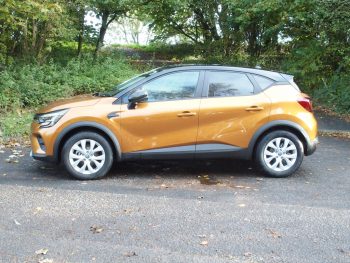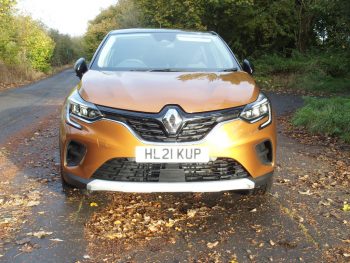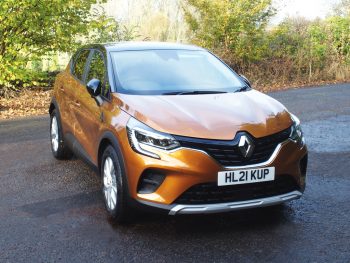Fleet World Fleet: Renault Captur Iconic E-Tech Hybrid 145 Auto
Our hybrid Renault Captur compact crossover heads back to base after six months on the Fleet World fleet.

The Captur has performed faultlessly during its time with us
Report 4
The Captur has come to the end of its time with Fleet World, having covered some 9,000 miles over the past six months. As we would expect of any modern car, it has performed faultlessly during its time with us. How do we rate Renault’s UK best-seller?
If you are looking for a small SUV with a high seating position and comfort is your priority, the Captur is definitely worth considering. It will seat four adults in comfort and there is reasonable boot space for a car of this size. Raise the false floor and there is room beneath to stow smaller items such as boots and shoes or if you need to keep items out of sight.
As I have mentioned in previous reports, the hybrid system works very well, switching between electric motor and petrol power to make the best use of the regenerated energy, while the choice of drive modes means you can restrict power to reduce fuel consumption by using ‘Eco’ mode. Even with this mode selected, the gearbox can change down unexpectedly when climbing a hill to provide extra performance but challenging refinement in the process. We averaged a fairly consistent 51.8mpg when the car was on test, occasionally making it above 52mpg. The hybrid drivetrain seemed to help to even out the variations between fuel consumption in city driving and out on the open road.
Despite the fairly compact dimensions, the Captur was a capable motorway cruiser easily coping with a couple of long trips to Scotland and back while we had the car, where its comfort was appreciated. As an alternative to a diesel fleet car, the Captur makes a good case for itself, more or less rivalling diesel fuel consumption.

The hybrid system in the Captur is easy to use and switches seamlessly between electric and petrol drive
Report 3
You can read plenty about the effectiveness of hybrid and plug-in hybrid drive systems in any number of magazines. The story, in all cases, is what sort of driving you will be using them for. There is also the aspect of preparing us for the electric car that you are most likely to drive in the future, by gaining an impression of what electric cars are like to drive while retaining the convenience of a petrol engine.
The hybrid system in the Captur seems to be well thought through. Like any hybrid system, it is at its best in stop/start traffic, but I find it interesting how often it switches into electric drive on motorways too.
The system is controlled from an automatic type selector which replaces the gear lever, supplemented by a couple of dashboard switches. To drive forwards, select either “D” or “B”. “D” is the normal automatic drive mode and “B” is the same but with additional regenerative braking. This can help to charge the hybrid system more quickly if you want to maximise electrical driving. It is also useful for controlling downhill speed and when driving in stop/start traffic. With practice you hardly need to use the brake pedal. The dashboard switches are for “Eco” mode, which will adjust settings to maximise fuel economy and also “EV”, which will select electric-only drive while there is enough hybrid battery power to provide it.
The system is easy to use and switches seamlessly between electric and petrol drive. My only criticism is when the system switches into petrol drive for hill climbing, when it can choose a low gear and rev harshly, which seems unnecessary. Assuming you would choose the hybrid Captur to provide good fuel economy, it’s a winner with diesel-like levels of fuel consumption.

Our testing so far has revealed the Captur is a comfortable car for longer journeys and being a hybrid is very well-suited to stop/start traffic and short distance running
Report 2
The Captur has certainly racked up the miles, helped by that early trip to Scotland and followed up by a few press trips before Omicron slowed activity in December. It has given me time to appreciate the car at length and my first impressions are being borne out. It’s a comfortable car for longer journeys and being a hybrid is very well-suited to stop/start traffic and short distance running.
Fuel consumption has settled down to a more-or-less constant 52.4mpg, indicated by the trip computer and I can’t help but admire how the hybrid system has been set up. It will switch swiftly from petrol power to electric drive whenever a suitable opportunity presents itself and it will always use electric drive for reversing if possible. The ‘B’ for extra regenerative braking gear selector position is a useful feature, helping to control downhill speeds and minimise the use of the conventional braking system in stop/start traffic. That said, the lever selector feels a bit clunky – the push button selector from its French rivals works much better, although the Captur provides a more impressive level of regenerative braking.
With 145hp available to it, the Renault provides a reasonable level of performance, but it tends to roll a fair bit when pushed and is much more at home as a sedate and refined means of transport.
Our Captur comes with a charging pad for phones but it seems reluctant to do so. It will usually display a message suggesting that a piece of metal needs to be removed from the pad for it to work properly. I haven’t worked out what it means yet – I never leave anything metal on the pad except the case of my phone. I need to investigate further.

Since the Captur went on sale in 2013, it has become the best-selling Renault model in the UK
Report 1
I would be the first to say that the B-segment SUV was never designed for me, but you only need to take a look on the roads to see that I am hopelessly outnumbered. There is no shortage of them. The Captur story is similar to that for rival manufacturers – since the model went on sale in 2013, it has become the best-selling Renault model in the UK, with more than 150,000 finding buyers.
The second-generation Captur went on sale here in 2020, based on the new CMF-B modular platform, with hybrid models joining the range for the first time. The hybrid range consists of the E-Tech Hybrid 145 Auto and E-Tech Plug-In Hybrid 160 Auto. Our test model is the E-Tech Hybrid 145 Auto in Iconic trim. The petrol/electric system generates 142hp and
Iconic trim includes an array of safety features including lane keeping assist, lane departure warning and active emergency braking. Keyless entry is also standard, along with 7-inch touchscreen navigation a 4x20W amplifier, with DAB radio, ‘sound auditorium’, two USB sockets, wireless phone charging and Apple Car Play/Android Auto phone connectivity.
One of my first trips in the Captur was a 1,000-mile round trip to Scotland and back. It was a good way to find out what keeps buyers queuing for the Captur. The ride quality is clearly one of the factors. It is impressive for a comparatively short car and, even after several hours at the wheel, the seats also proved supportive and comfortable. The split boot compartment provides storage to keep items out of sight whether they are boots and shoes or laptops.
It takes a while to get used to the hybrid powertrain’s behaviour. It can switch from electric drive to coarse high-revving engine in a split second, even in Eco mode, which is a bit difficult to understand. On the way to Scotland, fuel consumption dropped to around 55mpg indicated, not far off the WLTP combined figure, but strong winds and heavy rain brought the figure down to around 51.5mpg at the end of the return journey, completed on just two tank fills with miles to spare. The ‘B’ regenerative brake boosting setting for the gear selector means you can just about eliminate brake pedal use in stop start traffic and undoubtedly helps to stretch fuel consumption.
So the Captur is off to a good start and would work well for many fleet car users with its combined comfort and low fuel consumption. We are looking forward to finding out what it’s like in the long term.
P11d (BiK): £23,630 (26% for 2022/23) MPG/CO2: 56.5 (combined) 114g/km Test MPG: 51.8mpg












